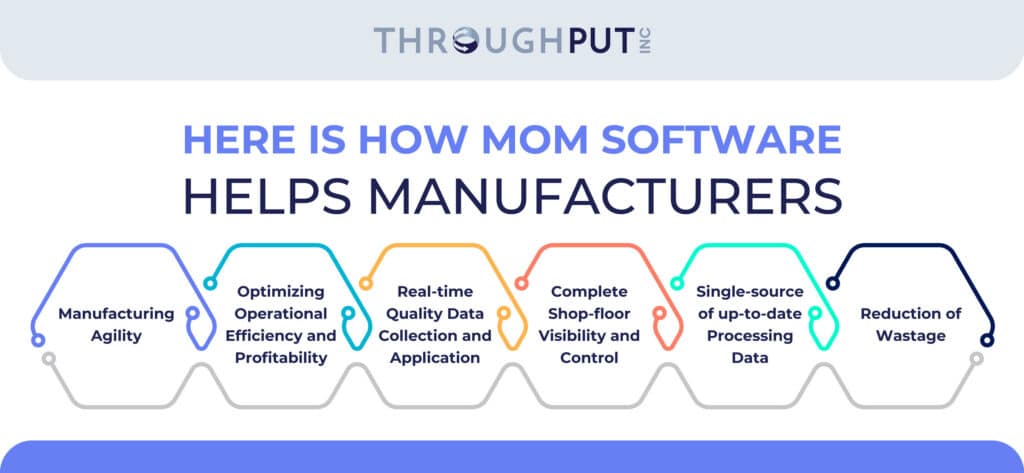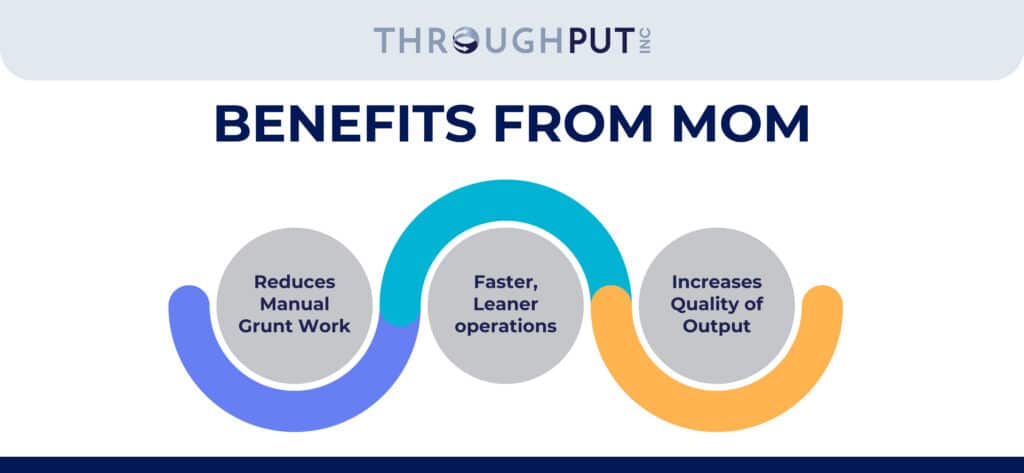Manufacturing Operations Management Software: A Plant Manager’s Handbook For Improved Shop Floor Control And Productivity

Today’s industrial landscape is unnervingly fast-paced. Plant managers can have a tough time managing shop floor operations and productivity efficiently.
We understand and that’s why have prepared this handbook as a comprehensive resource for plant managers.
This handbook will equip you with information, knowledge, and strategies to leverage manufacturing operations management software.
The practical applications of the software encompass optimizing and monitoring workflows in real-time while providing agility to manufacturing, reducing waste, and offering full shop-floor visibility and control to plant managers.
Refer to this handbook to streamline your operations, make well-informed decisions, and increase plant productivity.

What is Manufacturing Operations Management & Why Is It Important?
Manufacturing Operations Management (MOM) is a long-term holistic solution that gives complete visibility into plant floor operations to help consistently improve manufacturing operations performance.
A good MOM combines all essential production processes to enhance quality management, boost operational excellence and help in advanced planning and scheduling activities.
A MOM is important. It is essential for all-round optimization – efficiency, productivity, and profitability. With real-time visibility into shopfloor operations facilitating proactive decision-making and agility to respond to changes and fluctuations. Manufacturing Operations Management helps reduce downtime, improve quality control, and optimize resource allocation with the help of automation and streamlining workflows.
With MOM, plant managers can foster an environment of continuous improvements, holistic analysis, compliance with standards, and minimize risks while boosting a competitive edge for the business.
What is Manufacturing Operations Management Software?
Manufacturing Operations Management Software streamlines operations by integrating and coordinating shop-floor automation tasks with broader production workflows and support activities, linking them directly to the enterprise’s overall reporting system.
A reliable MOM Software can provide valuable visibility and insights for plant managers, operators, and supervisors to help take necessary actions for sustained operational excellence.
MOM Software has shown a steep increase in market size over the years. The market size was valued at $7.21 billion in 2018 and this is expected to reach $15.21 billion by 2026, showing a CAGR growth rate of 9.5% from 2019 to 2026.
How Can Manufacturing Operations Management Software Help?
The manufacturing industry has witnessed a rapid flux in the past few years given the instant demand/ supply market changes and disruptive innovation. This has created the need to evolve manufacturing processes to adopt manufacturing operations management functionalities and further integrate MOM into various operational domains through business process automation.
Manufacturing Operations Management Software helps in facilitating this. The software operates on a collection of systems that are used to manage end-to-end manufacturing operations processes with the basic objective to optimize the efficiency of complex manufacturing operations.
The software involves a definite set of processes that constantly improve the core operational activities on the shop floor. This is done to meet the strategic objectives of enabling product innovation, operations cost reduction, regulatory compliance, inventory management, and quality maintenance.
The software involves a definite set of processes that constantly improve the core operational activities on the shop floor. This is done to meet the strategic objectives of enabling product innovation, operations cost reduction, regulatory compliance, inventory management, and quality maintenance.

1. Complete Shop-floor Visibility And Control
Manufacturing Operations Management Software can provide essential information to manufacturers to help continuous improvement over weaker processes. This is possible through lean manufacturing principles and operational quality compliance.
2. Single-source Of Up-to-date Processing Data
MOM Software can help plant managers maintain a single unique source of critical engineering data. This would be the ready reference for important information such as part specifications, important plant assembly instructions, equipment maintenance records, etc.
3. Reduction Of Wastage
A good MOM Software can help trigger those manufacturing systems that can help in waste reduction. Most often this is related to the inventory management function which directly helps monitor inventory levels and therefore controls potential stockout issues.
4. Manufacturing Agility
With sound MOM Software, manufacturers can control shop floor performance despite fluctuating demand cycles, while managing product/ service costs and quality effectively. This gives the necessary agility to quickly adapt to changes proactively while saving time, resources, and effort.
5. Optimizing Operational Efficiency and Profitability
Better management of industrial operations can have significant business benefits. MOM Software aims to eliminate manual approaches to operational efficiencies by automating processes and this helps improve the bottom line and profitability for manufacturers.
6. Real-time Quality Data Collection and Application
Today’s MOM software application solutions help manufacturers collect accurate real-time data related to products, operations steps, inventory, labor, etc. This information can then be processed with relevant insights and reports made available through enterprise-level Enterprise Quality Management Software (EQMS) quality information systems.
Examples of How a Manufacturing Operations Management Software Can Help
Example 1: A leader in advanced sensor technology for commercial and defense navigation, faced challenges in their complex production processes involving over 50 steps. Despite increasing demands from the booming aviation industry, their production couldn’t be sped up due to the precision required and the lack of visibility into their operations, leading to bottlenecks and inefficiencies.
With the implementation of Throughput’s AI-powered Supply Chain software, the company increased operational capacity by 20% and cut processing times by 10%, boosting annual savings up to $10 million. The software processed vast amounts of real-time data from various systems, providing actionable insights that eliminated bottlenecks and improved Overall Equipment Effectiveness (OEE) and operational visibility. This enhancement allowed the client to maximize productivity and quality, significantly reducing resource wastage and missed sales opportunities.

Example 2: Post-COVID-19, the construction industry has faced significant demand fluctuations, especially for innovative solutions, amidst a constant labor shortage and pressure for timely deliveries. Conventional capacity planning methods have become ineffective due to unpredictable demand.
A leading construction company specializing in materials like gravel, sand, and cement, utilizes modern production technologies, aimed to enhance on-time delivery, optimize their product mix, and increase sustainability and competitiveness.
They sought to use existing data to improve delivery schedules, enhance capacity utilization with AI-driven demand sensing, and adjust product and customer mix based on changing demand, using diverse data sources including sales and weather information.
Throughput’s AI-powered Supply Chain software suite enabled the company to optimize delivery service levels and improve on-time delivery performance, leading to increased sales volumes across different customer segments and products. The software helped the company achieve flexible supply capabilities with faster response times, higher ROI, and reduced waste and inefficiencies across their supply chain. It streamlined scheduling systems to proactively reduce costly delays, downtime, and bottlenecks.
Throughput’s industry-specific algorithms applied critical forecasting factors in real-time to optimize the product mix, ensuring consistent profit margins.
The software enhanced resource utilization, aligning upstream and downstream systems to bolster revenue streams and profit margins, while minimizing operational costs, and cutting inventory and transportation expenses.
As a result, the company achieved over $1.5 million in annual savings from operations and working capital, improved material flow, increased gross margin by at least $875,000, and reduced annual working capital by over $450,000.
Types of Manufacturing Operations Management Software
1. PRODUCTION MANAGEMENT SOFTWARE
Production Management Software helps with real-time data about operating jobs, orders, labor status, materials, machine status, product shipments, and delivery schedules.
It helps prioritize the exact order in which materials are consumed and can overlook various batch execution procedures. This can help optimize order fulfilment by leveraging the detailed material and equipment tracking information.
PERFORMANCE ANALYSIS SOFTWARE
Performance Analysis Software provides accurate metrics at the machine, operations line, plant floor, and factory levels for specific situational or historical analysis. Distinct features like personalization can enable this type of MOM Software to provide different reports to managers and operators. These can be used to accelerate factory operations.
QUALITY AND COMPLIANCE SOFTWARE
Quality and Compliance Software is helpful to promote operations compliance against the set standards and specifications for operational processes and procedures. It is beneficial to help track deviations and measure the extent of deviation to, therefore, take corrective measures on time by plant managers.
Manufacturers use this software to ensure regulatory compliance and promote strict adherence to quality standards from certified bodies like the International Standards Organization (ISO).
HUMAN MACHINE INTERFACE (HMI) SOFTWARE
HMI Software enables plant operators and managers to effectively coordinate industrial processes and interact with specific process control machinery using a computer-based interface.
This interaction is through a graphical user interface that can facilitate information exchange and communication between two types of HMIs- the supervisory level and the machine level.
MANUFACTURING EXECUTION SYSTEM (MES)
The software helps enhance manufacturing productivity, quality, and flexibility by providing plant operators, production engineers, and plant managers the necessary insights to act and optimize.
They are able to work toward higher plant efficiency, enhanced productivity, and greater flexibility throughout the production processes.
MOM SOFTWARE FOR PROCESS AND PRODUCTION INTELLIGENCE
This software provides the necessary manufacturing intelligence needed to analyze operations trends and help inaccurate reporting. It helps in process improvements, quality control, and adequate asset management.
Consider Throughput, an AI-powered supply chain intelligence tool designed to enhance profitability and efficiency on your shop floor. Throughput maximizes capacity utilization and strategically allocates working capital for asset acquisition. It leverages real-time data analytics and provides predictive insights, helping you pinpoint potential bottlenecks, optimize production, and make informed decisions for optimal output. This innovative method not only boosts business productivity and performance but also reduces costs, maintaining a competitive edge in the marketplace.
What are the Benefits of Manufacturing Operations Management?
With an effective MOM strategy, both operations workers and plant managers benefit equally.
Benefits for Plant Engineers, Operations Workers, and Factory Floor Personnel:

Reduces manual grunt work: With an automated system in place, workers can quickly complete their day-to-day tasks without any bottlenecks. This eliminates dependency on manual repetitive work and makes way for large-scale automation.
Faster, leaner operations: Workers are able to easily manage work order execution by using electronic work directions to operators and also monitor the process and product quality improvement in manufacturing without too much back and forth.
This ensures uninterrupted production with minimal decision points.
Increases quality of output: With defined production processes in place, plant engineers are more aware of which materials need to be used to get the desired output. This boosts the overall quality and minimizes process variances.
Benefits for Operations Managers and Plant Supervisors:
Access to accurate plant information: With necessary operational data at their fingertips, managers are able to make quick decisions on important aspects. This reduces the time taken to complete the total production cycle loop.
Compliance with documentation: Managers can reduce the risk of recalls by ensuring products meet the necessary specifications. Accurate documentation of manufacturing operations processes also helps with instant traceability.
Operational excellence: A good MOM system can impact the ability of managers to achieve overall operational excellence for the entire plant. The manager now has end-to-end supply chain forecasting which makes it easier to meet operations targets.
Tight-knit business integration: Managers can now easily integrate manufacturing operations to other strategic business functions and take advantage of relevant opportunities that can optimize plant capacity planning
Next Generation of Manufacturing Operations Management Software: Powered by AI
Accenture’s findings suggest that AI can boost productivity by 40% or more by 2035 in the manufacturing industry, underscoring AI’s potential to revolutionize traditional manufacturing inefficiencies.
AI has the potential to transform the way manufacturing operations are done by delivering key benefits through demand planning, production, quality control, inventory management, product development, and maintenance.
Embedding AI into a Manunfacturing Operations Management system can help integrate user-defined rules and algorithms into the system to make it much more smarter.
Manufacturers can, therefore, rapidly analyze large volumes of data in real time and make routine decisions without the need for human intervention. Similarly, embedding AI into a real-time MOM system makes it more user-friendly for better results.
- Reducing the total data capture time to only focus on the essential data points needed and not any additional data units.
- Preventing errors by adhering to specific rules and algorithms that can alert the user about potential mistakes.
- A real-time tracker for plant managers, supervisors, and customer support teams which reduces the time spent on tracking order status and delivery schedules.
- Automatic and accurate job scheduling using a production schedule, pre-determined by rules and parameters set by the production manager.
- Real-time prediction of inventory shortage which helps managers plan for materials in advance.
One such critical application of AI in MOM is the real-time elimination of bottlenecks along the supply value chain. With accurate data-driven visibility, manufacturers can transform their operations and work toward predictable outcomes.
ThroughPut is an AI-powered bottleneck elimination engine that analyzes existing industrial data in real time. It continuously detects, identifies, prescribes & prevents your shifting operational bottlenecks in manufacturing to save millions in delays, inefficiencies & lost revenue. It takes away the pain of slow manual operations using AI-powered automated analytics. This results in manufacturing operational excellence through automated, sustainable and efficient operations across output KPIs.
If you wish to know more about how Throughput can help you in your MOM journey, click here for a demo.

To download this guide, click here.
